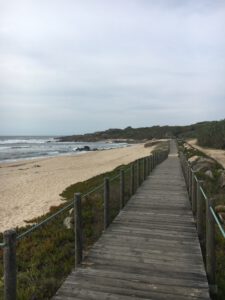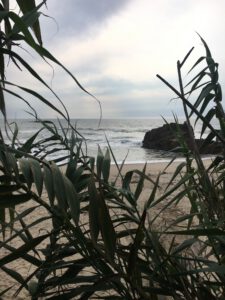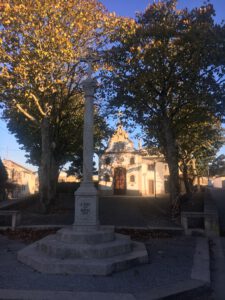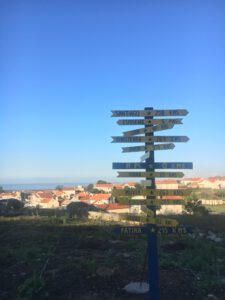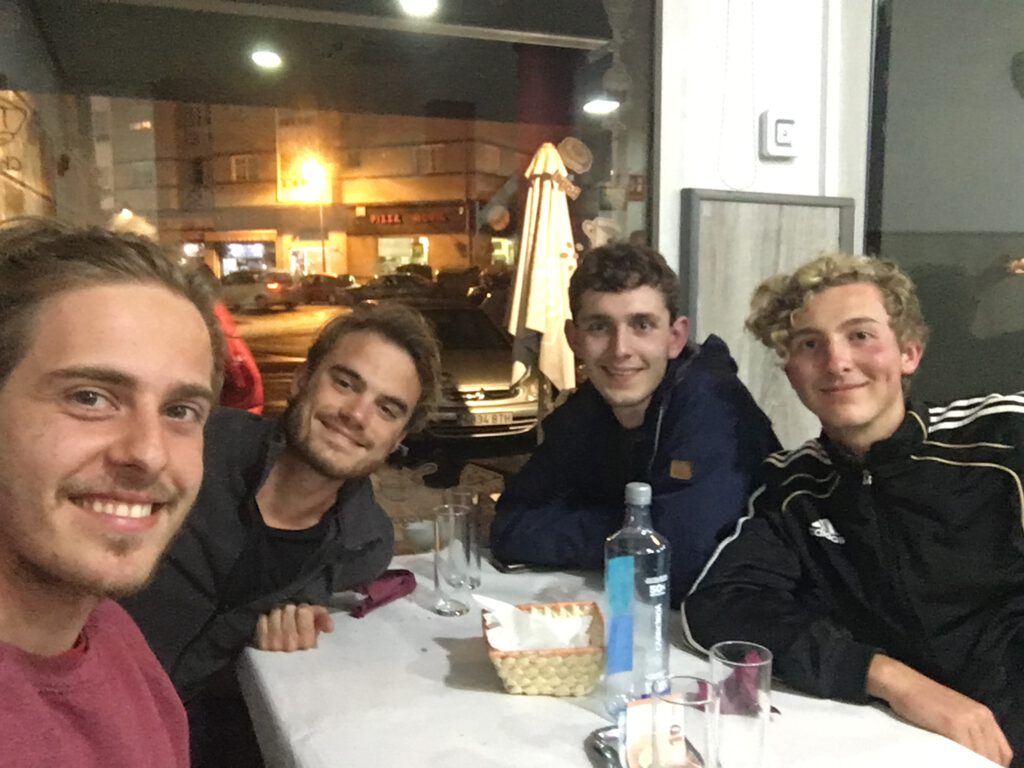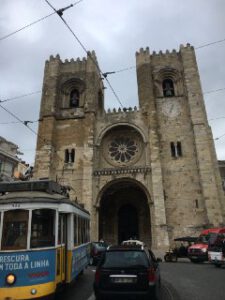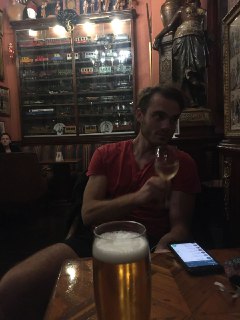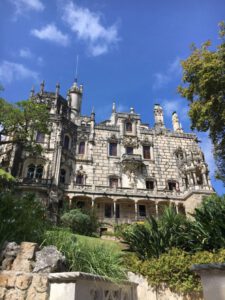Pawns are usually considered the least important pieces in a chess game. By itself, a pawn is doomed to die, but their strength lies in the cohesion with each other. We arrived in Redondela after 43 km of walking in just one day, exhausted, our legs were drained, but we met new pilgrims on the way, who would have shared the walk with us, and just like pawns we instilled force into each other. This metaphor became even more fitting, when, once we sat in a Bar to have Breakfast, before starting to walk, we were approached by a strange man who wanted to play chess with us. So, we started the day playing chess and discussing about German philosophers and writers, before effectively begin what we planned. In the end, despite waking up early, we left Redondela relatively late, but this is also the “Camino de Santiago”.

There was nothing special along the way from Redondela to Pontevedra, but I would like to stress out the matter of the equipment. We were surprised in the middle of the forest by heavy rain, and walking in the mud with non-waterproof shoes is not properly like a thermal mud massage. So, if you plan to do the “Camino” I strongly recommend to bring very good and comfortable shoes (Hiking boots are an overkill for the Camino but there are some shoes which are something in the middle between hiking boots and sneakers that are excellent on these types of grounds).
Arrived in Pontevedra all wet and dirty, we took some time to visit the city. This small medieval helmet is a precious piece of jewellery nestled on the Ria de Pontevedra, and it is probably the most characteristic city we met along the road. Of course, we started from the “Iglesia de La Virgen Peregrina” (church of the pilgrim Virgin). Its round façade is already peculiar by itself but entering is even more impressive. The statue of the virgin dominating from the Chancel above the altar, with her orange coat, the pilgrim’s hat and the stick is there to tell the pilgrims that they are at a turning point in their itinerary. It is also very suggestive to walk down in Praza da Estrela and have a glance at the “San Francesco Convent” where we had the opportunity to attend the mass during the Holy communion. I also recommend to get lost in the cobblestones paved streets and little alleys, maybe in this wandering, you’ll have the chance to reach the Praza Da Lena or the Ruinas de San Domingos and remain enchanted by the charming and warm atmosphere the city can offer.





The day after we walked down the ancient “Ponte do Burgo” bridge, and we decided not to continue on the traditional way but to pick the so-called “Variante Espiritual”, a special variant of the “Camino Portugues” which passes by monasteries and allows the pilgrim to travel along the Rio Ulla on a boat, reliving the last trip of Santiago, when its ashes were delivered to what now is called Santiago de Compostela by his two disciples: Atanasio and Teodoro. Passing by the swampland of “Parque da Seca” we reached the small town of Combarro.



This city has a peculiarity: it is filled with some structures resembling little temples, the Horreo, even though these are not real temples. These structures, which are typical of the Galician region, are just warehouses for wheat. They are built in this peculiar way because Galicia is a very rainy area, so it is useful not to have the wheat on the ground and in addition they feature breaches in the walls so that the wind can keep it dry. From Combarro the route climbs up the hill. The atmosphere that day was evocative thanks to the fog we met during our climb in the forest to the monastery of Saint Mary of Armenteira.



We spent one night in Armenteira and apart from the monastery there is nothing around. However, there is the possibility to assist to the mass in the monastery where the priest together with the nuns pronounces the blessing to the pilgrim. Attending it is strongly recommended. Even though the spiritual variant is not chosen by many pilgrims, in the small hostel we got the chance to know many new wayfarers and meet again some old faces.




Leaving Armenteira at our shoulders, we traversed the “Ruta da Pedra e da Auga”, a spectacular route which follows the flow of the river “Rego Da Armenteira”, trough musky trees, small waterfalls and leaps where the water gushes fast streaming down the hill passing below the watermills that crowd the path. Along the way, we even found a village made of stone, with its bakery, the church, farmers, animals and an unavoidable Horreo.
The path leads to Vilanova de Arousa, a little village lying on the Ria de Arousa. Here you can try the mussels and other kinds of shellfishes, which are typical of this region. Indeed, the Ria de Arousa is thronged with platforms for the farming of mussels. The Zamburinhas are strongly recommended, taste it if you pass by this region!!







Finally, the last day of “Camino” arrived. We boarded the ship which would have brought us from Vilanova to Padron along the only Via Crucis on water existing on earth. Crossing Vikings vessels (yes they arrived until these remote places) and small islands and patch of lands surmounted only by crosses drowned in the fog we reached the city where Santiago’s disciples landed. In the Padron’s cathedral, there is “El Pedron”, this Roman votive altarpiece of granite which, according to the legend, represents the piece of land where they made landfall bringing with them the rests of the Apostol.
We arrived quite early in the morning there, but we could not miss the chance to taste the “Pimientos de Padron”, so we had our breakfast with this typical plate of fried green peppers which have a peculiarity: the majority of them is not spicy but some of them are. In Spanish, there is the saying: “Pimientos de Padron unos pican Y otros no”, namely one is spicy and the other not.
After this light breakfast, we slowly approached our destination, roughly 25 km separated us from our goal. It was emotionally intense when, from far away, you could look ahead and see the town of Santiago de Compostela in all its splendour.

But even more heart-rending, was the arrival in “Praza do Obradoiro”, the majesty of the Cathedral provoking intense sensations in the pilgrims who arrive there and release their joy with chants and shoutings. In the square, the melting pot of the “Camino de Santiago” shows itself in all its glory, with a mixture of languages and sounds filling the air. The atmosphere is fantastic, absolutely astonishing, set in the marvellous frame of the French neoclassical palace, Pazo da Roxoi facing the cathedral. Exactly at its basement, we lied down, backs against the columns, bags hurled at our feet, the tiredness in our legs and our faces, but jet the happiness of living that moment. Looking at the cathedral’s façade we took the chance to free our thoughts and relax for a while. The spirits of all the pilgrims filling the square are almost palpable and the emotions cannot be described by words.
In the end, we collected the “Compostela” an official document of the catholic church, completely written in Latin, even our names were translated, certifying that we accomplished the Camino. Usually, in the afternoon there is mass for pilgrims where the “botafumiero”, an immense incense burner, is swung from the ceiling in the central nave (in my opinion to cover the pilgrim’s smell). Unluckily, the cathedral was under construction and so we could not attend this spectacular event. Luckily, we still had the possibility to visit San James’s tomb, our final goal.

Finally, after taking off the pilgrims’ cloaks, we enjoyed the nightlife in Santiago with a special Galician dinner and the “Queimada”. The latter was the last surprise this trip reserved us. It is a typical drink, prepared in Galicia, garnished with sugar, lemon, and orange peels. But the peculiarity stands in the fact that it is served inside a cauldron, the waiter sets fire to the liquor, mixes it and pours it in the cauldron while the customers have to pronounce a sort of magic spell to ward off the devil. For us, it was a farewell ritual, but even if my legs hurt and the ligaments disagree, I hope it was just a goodbye to Santiago. Because the Camino will always remain in our souls, and I am quite sure it will call us back to Santiago again in the future.









